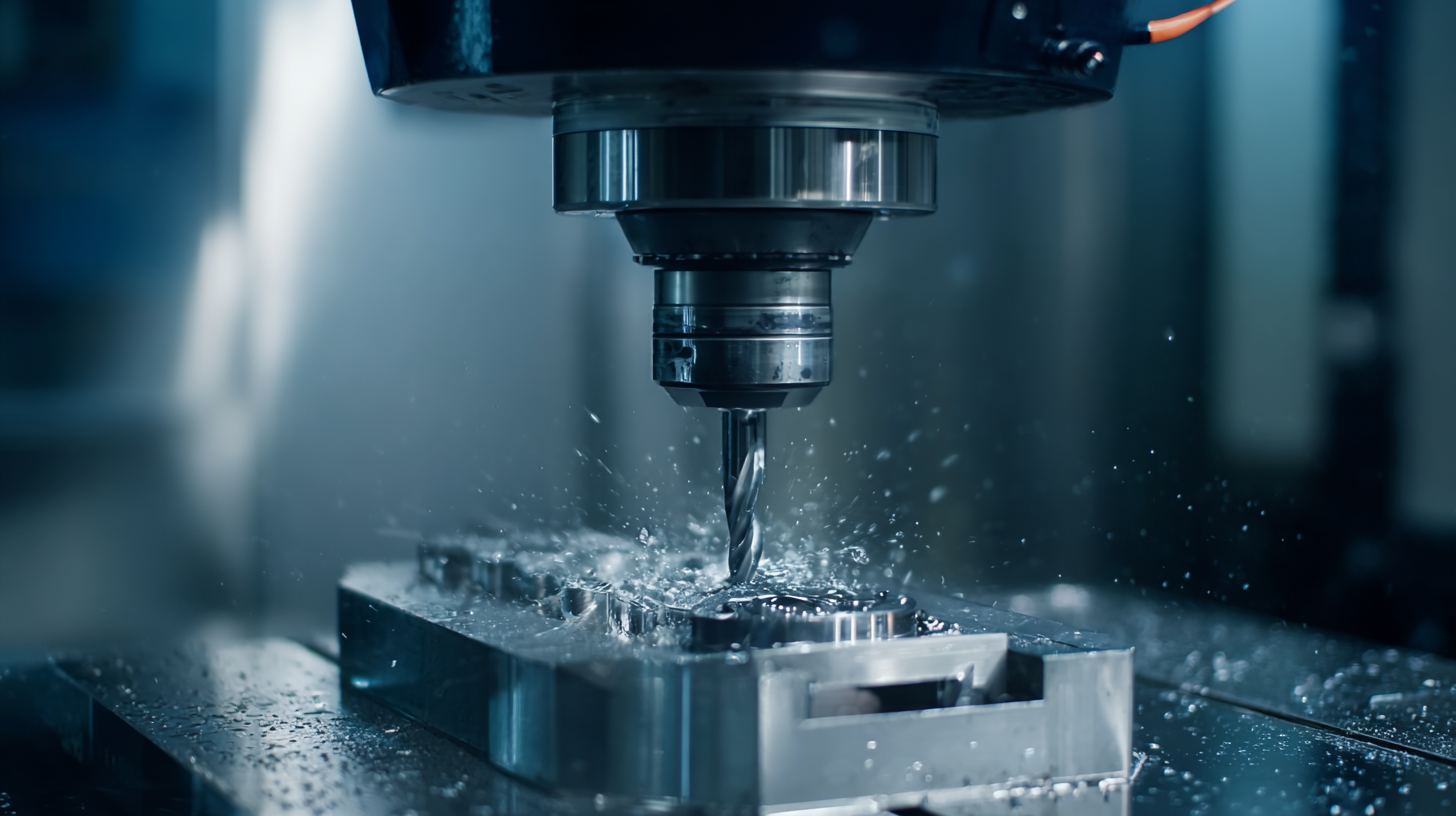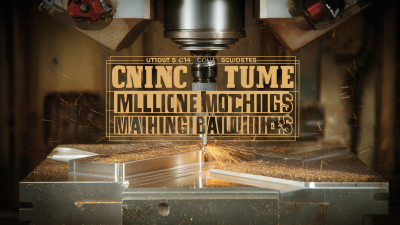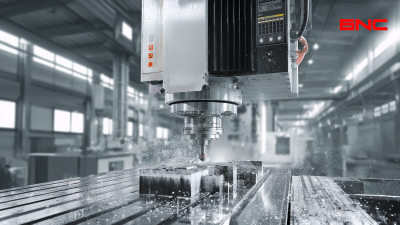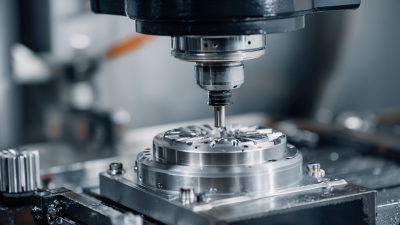Exploring the Future of Manufacturing with Advanced CNC Equipment Technology
The advent of advanced CNC equipment has revolutionized the manufacturing landscape, marking a significant shift towards precision and efficiency. According to a recent report by MarketsandMarkets, the global CNC equipment market is projected to reach USD 100 billion by 2026, growing at a CAGR of 6.5% from 2021 to 2026. This growth is propelled by the increasing demand for automated solutions that enhance production capabilities and reduce human error.

As manufacturers seek to stay competitive in an evolving industry, the adoption of cutting-edge CNC technology becomes imperative. From additive manufacturing to integrated IoT systems, the future of manufacturing is increasingly reliant on these innovative tools, promising enhanced quality control and operational flexibility. Understanding how to harness the full potential of CNC equipment not only drives efficiency but also establishes a foundation for sustainable manufacturing practices in the years to come.
The Impact of Advanced CNC Technology on Manufacturing Efficiency
The advent of advanced CNC technology is reshaping the landscape of manufacturing efficiency across various industries. By leveraging artificial intelligence and automation, companies can optimize their production processes, resulting in enhanced productivity and reduced operational costs. Innovative solutions provided by AI-driven systems allow manufacturers to analyze data in real-time, facilitating informed decision-making and minimizing downtime. This transformation signifies a shift from traditional practices to a more integrated and efficient approach to manufacturing.
Moreover, the incorporation of advanced CNC equipment is pivotal in elevating quality standards within precision manufacturing. By utilizing refined machining techniques and precision controls, manufacturers can achieve superior product quality with minimal waste. The rising trend of integrating AI into additive manufacturing processes further illustrates the potential of these technologies to revolutionize how products are designed and produced. Overall, the continuous evolution of CNC technology presents significant opportunities for manufacturers to redefine their operational strategies and gain a competitive edge in the global market.
Exploring the Impact of Advanced CNC Technology on Manufacturing Efficiency
This chart illustrates the improvements in manufacturing efficiency attributed to the integration of advanced CNC technology over the past five years. The metrics used are based on average increase in production speed (measured in units per hour) and reduction in production errors (measured as percentage decrease).
Emerging Trends in CNC Equipment for Precision Engineering
The future of precision engineering is being significantly shaped by emerging trends in CNC equipment, characterized by advancements in digital manufacturing technologies. As industries increasingly adopt these innovations, a notable shift towards high-precision and multi-axis machining centers is expected to redefine productivity standards. This transformation is driven by the rising demand for intelligent production networks and the integration of artificial intelligence, which are facilitating more efficient and adaptive manufacturing processes.

In addition, the CNC machine tools market is set to experience substantial growth, with projections indicating an increase in market value driven by the need for sophisticated machining capabilities. With significant investments in CNC advancements and smart automation, the milling machine sector is particularly poised for expansion. These advancements not only enhance the effectiveness of production but also open avenues for novel applications in various precision engineering sectors, signaling a promising evolution in manufacturing practices that will cater to the needs of future industries.
Integration of Automation and CNC Machines for Streamlined Production
The integration of automation with CNC machines is fundamentally transforming production processes across various industries. Advanced CNC equipment now leverages cutting-edge technologies such as artificial intelligence (AI), enabling predictive maintenance and automated programming. According to recent industry reports, implementing AI-driven solutions can enhance productivity in CNC machining by up to 30%, reflecting significant efficiency improvements. The application of adaptive machining further allows systems to respond dynamically to production variations, ensuring precision and reducing waste.

In addition to AI, automation solutions like integrated production lines have emerged as essential tools for modern manufacturing. Companies focusing on high-mix, low-volume production are increasingly adopting these systems to simplify operations. Reports indicate that the CNC machine market is anticipated to grow substantially, with a projected market size reaching billions by 2032. This surge is driven by the demand for increased efficiency and streamlined workflows, with automation playing a crucial role in achieving these objectives. Manufacturers are now recognizing that integrating sophisticated automation frameworks not only enhances operational efficiency but also paves the way for more innovative production strategies.
Future Innovations in CNC Technology: What to Expect
The landscape of manufacturing is on the brink of a significant transformation, largely driven by advancements in Computer Numerical Control (CNC) technology. According to a report by MarketsandMarkets, the global CNC machine market is projected to reach $100.38 billion by 2026, growing at a CAGR of 6.4% from 2021. One of the key innovations shaping this future is the integration of artificial intelligence and machine learning into CNC systems. These technologies can optimize machining processes, reduce downtime, and increase efficiency, allowing manufacturers to produce complex components with precision.
Furthermore, the rise of Industry 4.0 has prompted the incorporation of IoT (Internet of Things) into CNC equipment, enabling real-time monitoring and predictive maintenance. The Baker Hughes report highlights that predictive maintenance can reduce machine downtime by 50%, which is a game changer for manufacturers seeking to enhance operational efficiency. As these smart technologies continue to evolve, manufacturers can expect a leap in productivity and a reduction in operational costs, positioning CNC technology as a cornerstone of future manufacturing endeavors.
Best Practices for Implementing Advanced CNC Solutions in Factories
As manufacturers increasingly turn to advanced CNC (Computer Numerical Control) equipment, implementing these technologies effectively is crucial for enhancing productivity and reducing costs. According to a report from MarketsandMarkets, the CNC market is expected to grow from $72 billion in 2020 to $102 billion by 2025, highlighting the importance of integrating advanced CNC solutions in manufacturing. Best practices for implementation include thorough staff training and up-to-date skills development, aligning with the 2021 Deloitte report indicating that 70% of companies cited workforce skill gaps as a primary obstacle in adopting advanced manufacturing technologies.
Another key aspect is selecting the right CNC machinery that aligns with specific production needs. This involves conducting a detailed cost-benefit analysis to ensure that the investment in advanced CNC equipment pays off in terms of efficiency gains. A survey by the Association for Manufacturing Technology found that manufacturers utilizing advanced CNC tools reported a 25% increase in operational efficiency and a 20% reduction in waste. By focusing on tailored solutions and continual process optimization, factories can position themselves at the forefront of manufacturing innovation and outpace competitors in the evolving industry landscape.
Exploring the Future of Manufacturing with Advanced CNC Equipment Technology - Best Practices for Implementing Advanced CNC Solutions in Factories
| Dimension | Value |
|---|---|
| CNC Machine Types | Vertical Machining Centers, Horizontal Machining Centers, CNC Routers |
| Key Benefits | Increased Precision, Higher Production Rates, Reduced Waste |
| Common Materials Processed | Aluminum, Steel, Plastics, Composites |
| Implementation Challenges | High Initial Cost, Skilled Labor Shortages, Integration with Existing Systems |
| Maintenance Best Practices | Regular Calibration, Software Updates, Routine Inspections |
| Future Trends | Automation, IoT Integration, AI-Based Predictive Maintenance |
Related Posts
-

Unlocking Efficiency Through Innovative Applications of Best CNC Machine Tools in Various Industries
-

Ultimate Guide to Choosing the Best CNC Milling Machines for Your Business
-

Exploring Top Alternatives to the Best Vertical CNC Machine for Global Buyers
-

10 Reasons Why the Best CNC Turning Machine is Essential for Your Business
-

How to Select the Best CNC Machine Tools for Your Manufacturing Needs
-

The Future of Precision: Advancements in Best CNC Machining Centers
